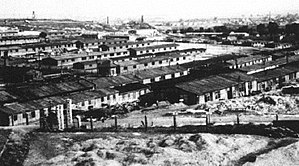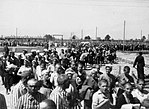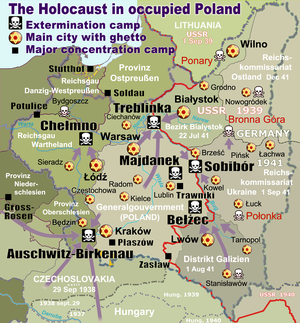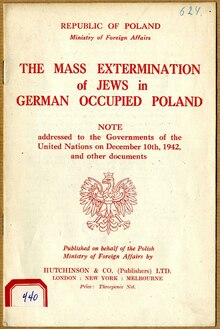
Nazi Germany used six extermination camps, also called death camps, or killing centers, in Central Europe during World War II to systematically murder over 2.7 million people – mostly Jews – in the Holocaust. The victims of death camps were primarily murdered by gassing, either in permanent installations constructed for this specific purpose, or by means of gas vans. The six extermination camps were Chełmno, Belzec, Sobibor, Treblinka, Majdanek and Auschwitz-Birkenau. Extermination through labour was also used at the Auschwitz and Majdanek death camps. Millions were also murdered in concentration camps, in the Aktion T4, or directly on site.

Majdanek was a Nazi concentration and extermination camp built and operated by the SS on the outskirts of the city of Lublin during the German occupation of Poland in World War II. It had seven gas chambers, two wooden gallows, and some 227 structures in all, placing it among the largest of Nazi concentration camps. Although initially intended for forced labor rather than extermination, it was used to murder people on an industrial scale during Operation Reinhard, the German plan to murder all Polish Jews within their own occupied homeland. In operation from 1 October 1941 to 22 July 1944, it was captured nearly intact. The rapid advance of the Soviet Red Army during Operation Bagration prevented the SS from destroying most of its infrastructure, and Deputy Camp Commandant Anton Thernes failed to remove the most incriminating evidence of war crimes.

Mauthausen was a concentration camp that first appeared in 1938, and the original Mauthausen camp was not situated precisely on the same spot as the latter more commonly known Mauthausen. The latter Mauthausen was situated on a hill above the market town of Mauthausen, Upper Austria. It was the main camp of a group with nearly 100 further subcamps located throughout Austria and southern Germany. The three Gusen concentration camps in and around the village of St Georgen/Gusen, just a few kilometres from Mauthausen, held a significant proportion of prisoners within the camp complex, at times exceeding the number of prisoners at the Mauthausen main camp.

Stutthof was a Nazi concentration camp established by Nazi Germany in a secluded, marshy, and wooded area near the village of Stutthof 34 km (21 mi) east of the city of Danzig (Gdańsk) in the territory of the German-annexed Free City of Danzig. The camp was set up around existing structures after the invasion of Poland in World War II and initially used for the imprisonment of Polish leaders and intelligentsia. The actual barracks were built the following year by prisoners. Most of the infrastructure of the concentration camp was either destroyed or dismantled shortly after the war. In 1962, the former concentration camp with its remaining structures, was turned into a memorial museum.

Around six million Polish citizens are estimated to have perished during World War II. Most were civilians killed by the actions of Nazi Germany, the Soviet Union, the Lithuanian Security Police, as well as the Organization of Ukrainian Nationalists and its offshoots.

Aufseherin was the position title for a female guard in Nazi concentration camps. Of the 50,000 guards who served in the concentration camps, approximately 5,000 were women. In 1942, the first female guards arrived at Auschwitz and Majdanek from Ravensbrück. The year after, the Nazis began conscripting women because of a shortage of male guards. In the context of these camps, the German position title of Aufseherin translates to (female) "overseer" or "attendant". Later female guards were dispersed to Bolzano (1944–1945), Kaiserwald-Riga (1943–44), Mauthausen, Stutthof (1942–1945), Vaivara (1943–1944), Vught (1943–1944), and at Nazi concentration camps, subcamps, work camps, detention camps and other posts.

Gross-Rosen was a network of Nazi concentration camps built and operated by Nazi Germany during World War II. The main camp was located in the German village of Gross-Rosen, now the modern-day Rogoźnica in Lower Silesian Voivodeship, Poland; directly on the rail-line between the towns of Jawor (Jauer) and Strzegom (Striegau). Its prisoners were mostly Jews, Poles and Soviet citizens.
The Jaworzno concentration camp was a concentration camp in WW2 German-occupied Poland and later in Communist Poland. It was first established by the Nazis in 1943 during the Second World War and was later used from 1945 to 1956 by the Soviet NKVD and then by the Ministry of Public Security and other agencies of the Polish communist regime. Today the site is an apartment complex and also houses a memorial to the camp's victims.
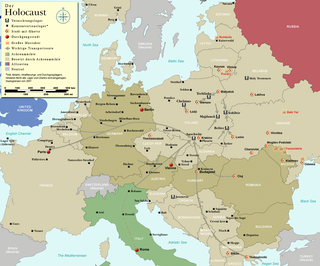
The terms "Polish death camp" and "Polish concentration camp" have been controversial as applied to the concentration camps and extermination camps established by Nazi Germany in German-occupied Poland. The terms have been criticized as misnomers. The terms have occasionally been used by politicians and news media in reference to the camps' geographic location in German-occupied Poland. However, Polish officials and organizations have objected to the terms as misleading, since they can be misconstrued as meaning "death camps set up by Poles" or "run by Poland". Some Polish politicians have portrayed inadvertent uses of the expression by foreigners as a deliberate disinformation campaign.
Franciszek Piper is a Polish scholar, historian and author. Most of his work concerns the Holocaust, especially the history of the Auschwitz concentration camp. Dr. Piper is credited as one of the historians who helped establish a more accurate number of victims of Auschwitz-Birkenau death camps. According to his research, at least 1.1 million people were murdered at Auschwitz-Birkenau, of whom about 960,000 were Jewish. He is the author of several books and chair of the Historical Department at the Auschwitz-Birkenau State Museum.
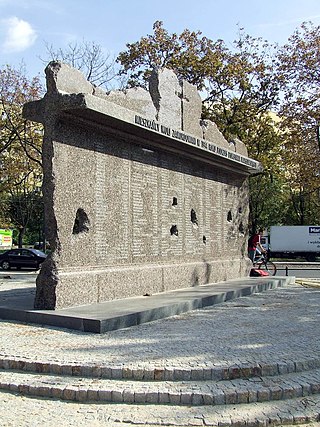
Crimes against the Polish nation committed by Nazi Germany and Axis collaborationist forces during the invasion of Poland, along with auxiliary battalions during the subsequent occupation of Poland in World War II, included the genocide of millions of Polish people, especially the systematic extermination of Jewish Poles. These mass killings were enacted by the Nazis with further plans that were justified by their racial theories, which regarded Poles and other Slavs, and especially Jews, as racially inferior Untermenschen.

Holocaust trains were railway transports run by the Deutsche Reichsbahn national railway system under the control of Nazi Germany and its allies, for the purpose of forcible deportation of the Jews, as well as other victims of the Holocaust, to the Nazi concentration, forced labour, and extermination camps.

Janowska concentration camp was a German Nazi concentration camp combining elements of labor, transit, and extermination camps. It was established in September 1941 on the outskirts of Lwów in what had become, after the German invasion, the General Government. The camp was named after the nearby street Janowska in Lwów of the interwar Second Polish Republic.

During the Holocaust, death marches were massive forced transfers of prisoners from one Nazi camp to other locations, which involved walking long distances resulting in numerous deaths of weakened people. Most death marches took place toward the end of World War II, mostly after the summer/autumn of 1944. Hundreds of thousands of prisoners, mostly Jews, from Nazi camps near the Eastern Front were moved to camps inside Germany away from the Allied forces. Their purpose was to continue the use of prisoners' slave labour, to remove evidence of crimes against humanity, and to keep the prisoners from bargaining with the Allies.
Sara Zyskind, alsoSara Plager-Zyskind, was a prominent Polish–Israeli writer on the Holocaust. She was a survivor of the Łódź Ghetto, and of the Auschwitz, the Mittelsteine concentration camp, and the Grafenort Nazi concentration camps. Her style as a writer on the Holocaust has been praised for its effective literary technique that allows the reader to identify with the reality of the period. Her writings constitute valuable primary sources in Holocaust historiography.

The Mittelsteine concentration camp was a Nazi Arbeitslager or slave-labour camp functional on the territory of Nazi Germany during the latter part of the Second World War.
It was originally established in 1942, but was operated formally for 250 days between 23 August 1944 and 30 April 1945 as an all-female subcamp of Gross-Rosen.
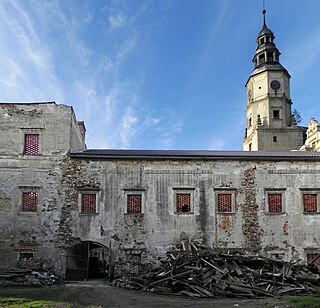
The Grafenort concentration camp was a subcamp of the Gross-Rosen concentration camp located in a castle in the village of Grafenort in Lower Silesia, which was operational throughout World War II. For 68 days from 1 March 1945, the camp was run exclusively as a women's subcamp, with between 250 and 400 female prisoners of Jewish ethnicity transferred from the Mittelsteine concentration camp. The reason behind the liquidation of Mittelsteine and the transfer of prisoners has not been fully understood. The prisoners at Grafenort were subjected to slave labor, building fortifications against the advancing Eastern Front of the Allies, and were known for receiving the most brutal treatment of any Nazi female concentration camp. The camp was liberated on 8 May 1945 by Soviet forces, and while some sources give different dates for the liberation, all Gross-Rosen subcamps were liberated between 8 and 9 May.

The Majdanek State Museum is a memorial museum and education centre founded in the fall of 1944 on the grounds of the Nazi Germany Majdanek death camp located in Lublin, Poland. It was the first museum of its kind in the world, devoted entirely to the memory of atrocities committed in the network of concentration, slave-labor, and extermination camps and subcamps of KL Lublin during World War II. The museum performs several tasks including scholarly research into the Holocaust in Poland. It houses a permanent collection of rare artifacts, archival photographs, and testimony.

During World War II, the German Luftwaffe staffed dozens of concentration camps, and posted its soldiers as guards at many others. Camps created for the exploitation of forced labor for armaments production were often run by the branch of the Wehrmacht that used the products. The Wehrmacht also posted about 10,000 soldiers to concentration camps because of a shortage of guards in mid-1944, including many from the Luftwaffe.
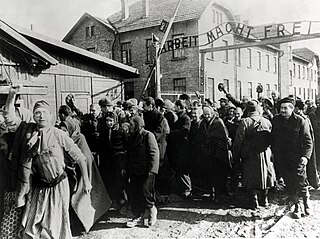
On 27 January 1945, Auschwitz concentration camp—a Nazi concentration camp and extermination camp in occupied Poland where more than a million people were murdered as part of the Nazis' "Final Solution" to the Jewish question—was liberated by the Soviet Red Army during the Vistula–Oder Offensive. Although most of the prisoners had been forced onto a death march, about 7,000 had been left behind. The Soviet soldiers attempted to help the survivors and were shocked at the scale of Nazi crimes. The date is recognized as International Holocaust Remembrance Day.
